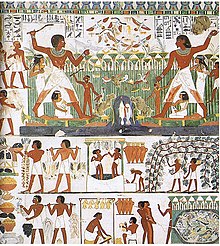
Nilotic landscape is any artistic representation of landscapes that emulates or is inspired by the Nile river in Egypt. The term was coined to refer primarily to such landscapes created outside of Egypt, especially in the Aegean Sea, and generally in Roman art, though it is occasionally used to refer to scenes of hunting and fishing in Egyptian art. A nilotic landscape is a river scene with rich and abundant plant and animal life, much of which is native to Egypt. Common iconographic elements include papyrus, palm trees, fish and water birds, and in some cases felines, monkeys, and/or crocodile. Imperial Roman scenes have a larger emphasis on fierce animals, usually including at least one crocodile and hippopotamus.
Archaeological evidence attests to painted depictions of the Nile in Egyptian tombs as early as the Predynastic period. Nilotic scenes remain popular throughout the Old and Middle Kingdoms, and flourish in the New Kingdom. Of particular prominence are landscapes in tomb paintings of the 18th Dynasty of Egypt. Nilotic landscapes are first adapted outside of Egypt in the Aegean, notably in Minoan art. The subject enjoys a renaissance in Hellenistic and Roman art, when nilotic scenes become a common subject for mosaics, most famously the 1st-century BC Nile mosaic of Palestrina. There were also paintings, which have much more rarely survived. These images emphasized the exoticism of the Nile, as well as its busyness as a waterway. Scenes of water traffic are depicted next to abundant and often dangerous wildlife.


The production of nilotic landscapes as well as their iconography and interpretations depend on the provenance of the work and the culture in which it was produced, but most scenes on the whole affirm and celebrate the abundance of nature.